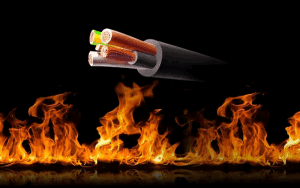Halogens (meaning “salt formers”) include the chemical elements chlorine (Cl), bromine (Br), fluorine (F), and iodine (I). In cable manufacturing, these elements are used to make certain insulation and sheathing materials flame-retardant. Chlorine (which is a component of PVC plastic or chloroprene rubber) and fluorine (found in the high-temperature materials FEP, PTFE, and ETFE) play a role here. Even bromine is used in flame retardants for cables and wires.
The problem is that halogens burn very aggressively and emit toxic fumes when ignited. They produce halides which, when in contact with moisture, turn into acids that can cause acid burns in the respiratory tract. In addition, the released acids can corrode metal parts, which can damage machinery and even the reinforcement of concrete in buildings. This can result in time-consuming and expensive remediation measures.
The flame retardancy of cables and wires is of course an important criterion for fire prevention measures. There are also a number of applications that explicitly require halogen-free products, which means that cables and wires consist of materials that are free of chlorine, bromine, fluorine and iodine. If these cables catch fire, they produce much less acid and smoke, and are less toxic, which significantly reduces the consequential damage to people, buildings and machines. However, even halogen-free cables still emit toxic gases such as carbon monoxide when they catch fire.
For example, halogen-free cables and wires are required in buildings where people come together and where valuable material goods need to be protected. Examples include:
- Building technology: Public buildings such as offices, shopping malls, schools, hospitals and airports are subject to strict fire and health regulations. Most cables and wires in these buildings are permanently installed and do not have to meet any special chemical or mechanical requirements. PE or PP-based plastic compounds are often used here, which are halogen-free, flame-retardant and produce little smoke or toxic gas. They also often have to pass bundle combustion tests.
- Industrial Automation: Machines and installations often require cables and wires with high chemical and mechanical resistances. When used in flexible applications such as in drag chains or in robotics, these loads are particularly high. Typically, sheathing materials based on TPE-O or TPE-U (PUR or Santoprene) are used here. These are also available in halogen-free versions, but cannot be produced as flame-retardant or low-smoke as cables for building technology.

 Halogen-free cables are a required standard in a wide range of industrial and infrastructure applications. Over time, different names for these cables have emerged, such as FRNC, HFFR, LS0H or LSZH. But how meaningful are these abbreviations, and what are the advantages of halogen-free cables compared to products containing halogens? Let HELUKABEL explain it to you.
Halogen-free cables are a required standard in a wide range of industrial and infrastructure applications. Over time, different names for these cables have emerged, such as FRNC, HFFR, LS0H or LSZH. But how meaningful are these abbreviations, and what are the advantages of halogen-free cables compared to products containing halogens? Let HELUKABEL explain it to you.